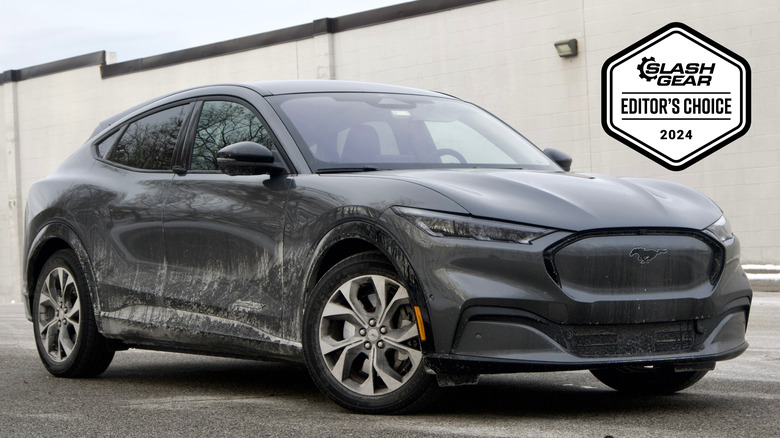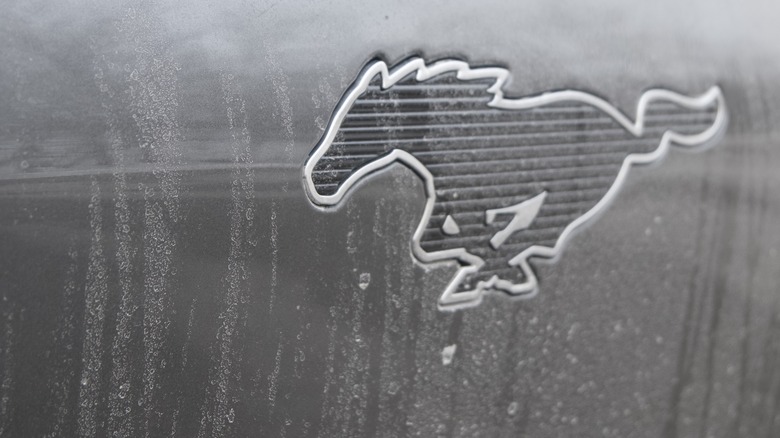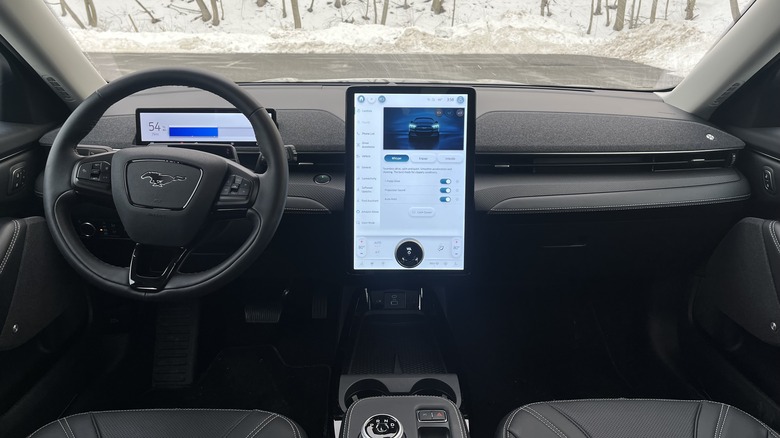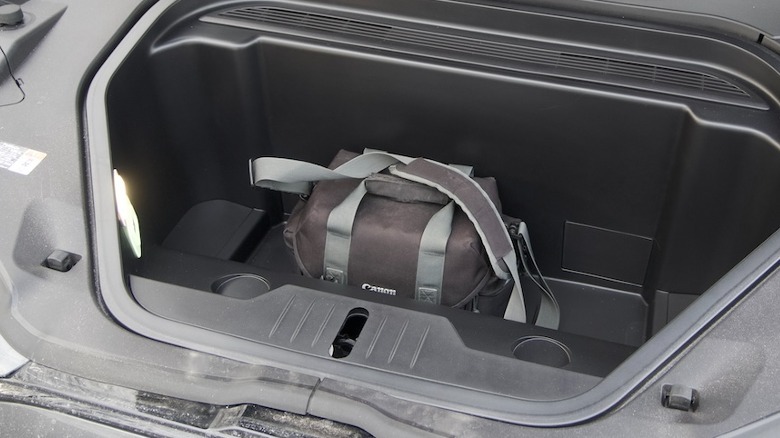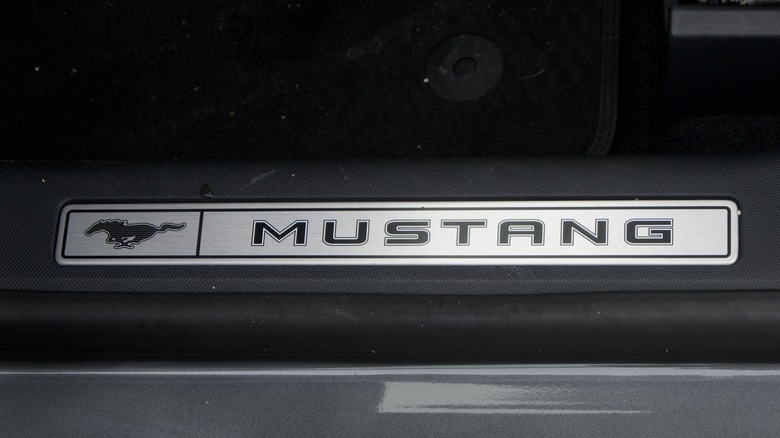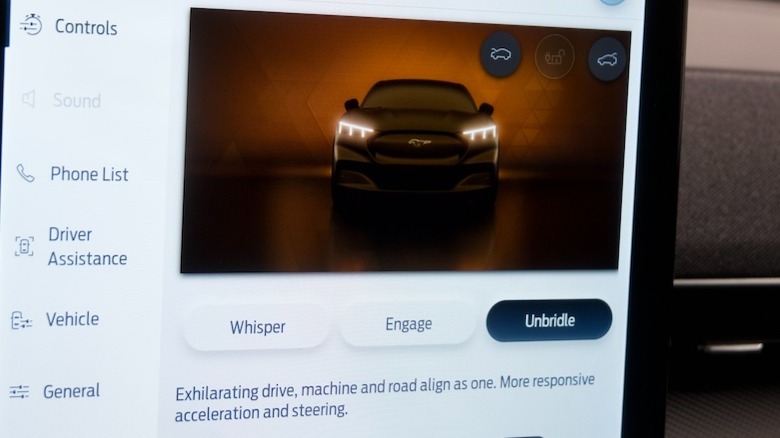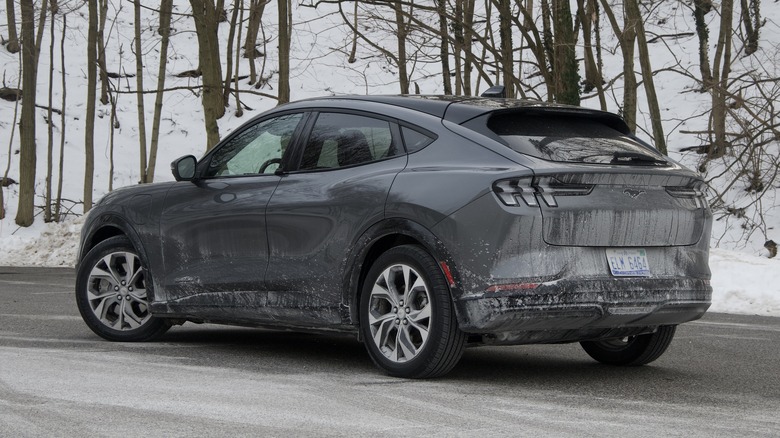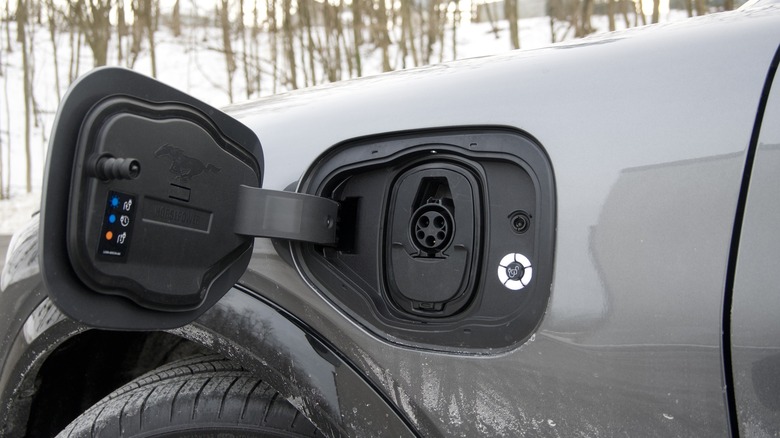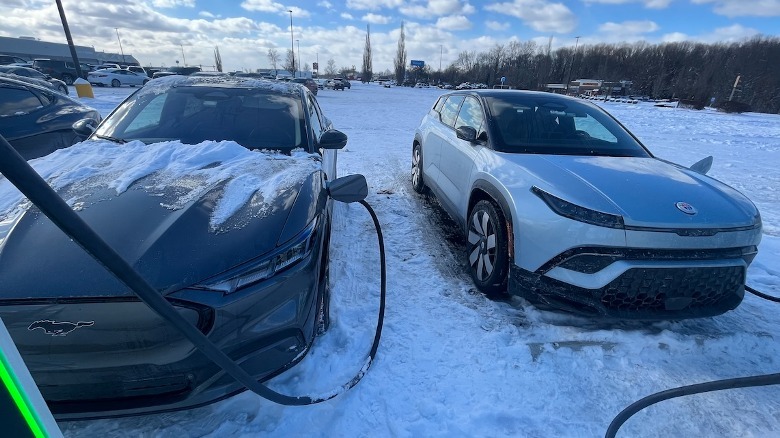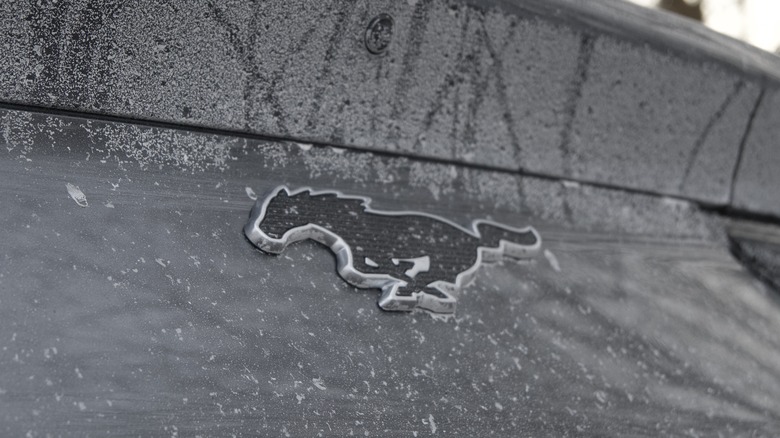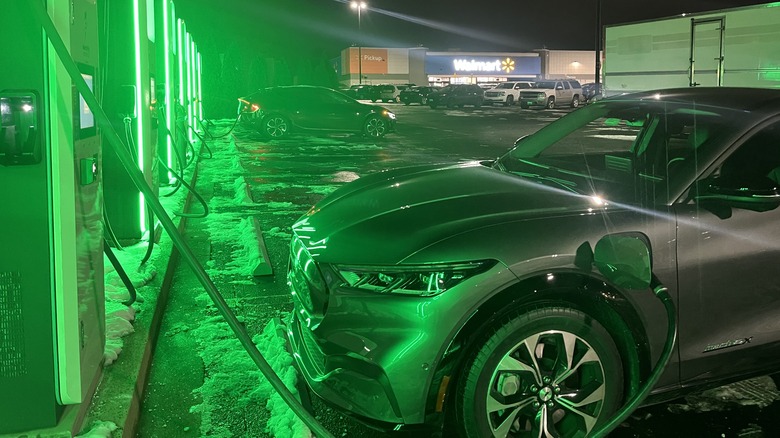Ford's Mustang Mach-E Is A Great Car, But That's Only Half The EV Problem
- Quiet cabin
- Startlingly quick
- Remarkably easy to drive
- Spartan interior
- Cold weather is not its friend
- Expensive compared to the competition
In the current landscape, there are essentially two categories of electric cars that are commercially available: Tesla, and everyone else. The Ford Mustang Mach-E Premium is firmly in the latter category. Among the automotive crowd, Tesla has become steadily more unpopular, with Elon Musk being a primary reason for many. To everyone else, a Tesla is the de facto electric car with options from legacy automakers like General Motors and Ford being treated like the store brand version of a proper EV.
You simply can't talk about any non-Tesla EV without mentioning its relation to Tesla. Love or hate the company, it has irreversibly altered the alternative fuel vehicle landscape.
Unlike Tesla, Ford has been making cars nonstop for the better part of a century, producing automotive icons like the Ford F-150 and Mustang. The Big Blue Oval's two main electric cars are modeled after those icons to a varying degree of closeness. The F-150 Lightning just looks like a run-of-the-mill F-150, albeit with some lighting changes and the fact it, you know, doesn't have an internal combustion engine. The Mustang Mach-E is a Mustang really in name only. Since 1964 and a half, gas-powered Mustangs have primarily followed one shape: a two-door coupe, and the Mach-E is not one of those. It's a four-door crossover (maybe a wagon?). It does, however, have several Mustang badges on it, instead of the Ford oval.
A Mustang in name
Online, the Mach-E may be judged unfairly given the gravitas behind its very name, but equine nomenclature aside, how does it act as an actual car? If electric vehicles are supposedly primed to take over internal combustion powered cars any day now, how does an offering from one of the most well-known companies in human history perform?
To figure that out, a 2023 Ford Mustang Mach-E Premium fitted with a 91 kWh extended range battery and two electric motors arrived on my driveway. With both motors working in unison, it generates a combined 346 horsepower and 428 pound-feet of torque. Despite its pedestrian silhouette, the Mach-E actually produces more horsepower and torque than a base model 2.3L EcoBoost-powered Ford Mustang, which only pumps out 315 horsepower and 350 pound-feet of torque. SlashGear has reviewed the base model 2023 Mach-E Select RWD as well.
Being an electric car, range is the most important specification. According to Ford, this Mach-E with its extended battery had an estimated range of 290 miles, although in real world use, that won't necessarily be the case. For charging speed, the Mach-E has access to Ford's BlueOval charging network, and in theory any 150 kW DC fast charger using the CCS charge port (also an important plot point during my week with the Mach-E).
Premium is right
As a four-wheeled street-legal means of conveyance, the Mustang Mach-E Premium was nothing short of spectacular. The interior, finished in a material Ford calls "ActiveX," was eerily quiet due to the lack of engine noise, but I very quickly got used to it and even enjoyed the total lack of internal combustion-related sounds. The Bang & Olufsen 10-speaker sound system is phenomenal and, without getting too much into the weeds on the audiophile end, enhanced by the absence of the typical automotive cacophony. The EV was spacious enough to fit four adults comfortably, and the front trunk — or "frunk" — was actually usable and the perfect spot to store my camera gear.
A family friend of mine is a retired union electrician from the Michigan area and has a soft spot for any car from the Big 3. I had the great honor of driving him a small loop around his neighborhood and he was overjoyed that an electric vehicle, especially one from Ford, was not only really comfortable to be in, but has enough "get up and go" to be useful in daily driving and even be ever so slightly fun to be driven in.
A dash of humor
On the performance end, the dual-motor eAWD setup allowed the Mach-E to launch itself to highway speeds startlingly quickly and without any real noise aside from the whine of the electric motors. Ford says it can go from a dead stop to 60 miles per hour in 4.8 seconds; certainly more than fast enough to scare my mom and make a dad burst out laughing, especially when switched to "Unbridled" mode. The Mach-E is a serious shot across the bow at Tesla, yet not without its own goofy charm. After all, a quote from German theologian Dietrich Bonhoeffer reads "Absolute seriousness is never without a dash of humor."
From a price standpoint, the Ford Mustang Mach-E Premium isn't cheap or humorous. But in its defense, it didn't feel cheap either. The base price of the Premium will set you back 57,675 environmentally conscious dollars. The extended range battery adds $8,600 to that price. Throw in a $1,300 destination charge, and you're looking at an MSRP of $67,575. For comparison, a new Tesla Model Y Extended Range, a similarly shaped vehicle, carries a price of $37,890.
BlueCruise at the helm
This Mach-E was also equipped with Ford's Level 2 driver assistance technology, BlueCruise, more specifically BlueCruise 1.2. This feature doesn't allow the car to drive itself, but it acts as a sort of enhanced cruise control and advertised as a "Hands-Free" system. When you're on a stretch of road that's compatible with BlueCruise, pressing the cruise control button activates the feature. The only stretch of road near me that was compatible with BlueCruise was Interstate 83, which spans from Harrisburg, Pennsylvania to Baltimore, Maryland.
Once the Mach-E informed me that BlueCruise was available, I pressed the button to give control over to the Ford and took my hands off the wheel. However, my hands-free driving career was short-lived. I found BlueCruise's ping-ponging between the road markings to be so disconcerting that I started to lose faith in the system. Before giving up entirely, however, I prompted a lane change by flipping the turn signal indicator. It changed lanes without any fanfare and at decidedly its own plodding pace, but it did do so safely.
For the sake of disclosure, the section of I-83 I was driving on was covered in salt and remnants of snow, which may have confused the elves controlling the Mach-E, so your BlueCruise experience may vastly differ from my first impression.
Charging woes
During my week with the Mach-E, my longest time driving an EV, I wondered if I could live with one as my only car. The answer, unfortunately, is a resounding "no." It all boils down to charging. Nearly every factor of my current living situation precludes me from having convenient access to an EV charger. I live in an apartment, meaning that I do not have access to anything that can pump out more current than a 110 volt wall outlet. There are also no outside-facing plugs.
Additionally, I live in Southern Pennsylvania, near the city of York. There are no DC fast chargers in the entire county (there are plenty of NACS Tesla chargers, just nothing that supports a CCS plug). The closest fast charger within the state of Pennsylvania was over 50 miles away. Over the state line in Maryland, the closest was almost 40 miles away. An 80 to 100 mile round trip just to charge is the opposite of convenient. For what it's worth, when I was able to access a DC fast charger, in this case an Electrify America station, it was pretty painless and free from the technological gremlins that sometimes plague EV chargers. I even parked next to a Fisker Ocean, which was a rare treat.
Who bears responsibility?
To make matters worse, it was very cold when I had the Mach-E, at times hovering around 12 degrees during the day. Cold weather and EV batteries don't mix. The 290 miles of range I mentioned earlier was closer to 160 or 170 when nature was working overtime. The computer of the poor Mach-E couldn't always reconcile with the cold weather, dropping over six miles of range during the one mile drive to the grocery store.
As I parked it for the final time, the battery was listed at 54% with a range of 79 miles. When it was picked up for its return to the shop, 35 miles away, the battery showed 32% and a range of 72 miles. That unpredictability would making living with the Mach-E stressful, and Ford doesn't use a much more efficient heat pump for its climate control. If it was equipped with that, instead of the more power hungry setup it has now, it might be a different story.
Is it Ford's responsibility to ensure that everyone who buys one of its EVs has the ability to charge it? Ford doesn't make sure you live near a gas pump before buying a gas powered car, as there has already been infrastructure in place for the past century or so that ensures you are never far away from fuel. But given that the nationwide proliferation of EV chargers hasn't happened yet, should Ford and other automakers shoulder the burden of installing chargers everywhere? That's not a question I have the answer to, but it's a question that should be asked of automakers. Tesla Superchargers are everywhere. If Ford, GM, Kia, Hyundai, or others want any shot of market supremacy, they need to step up to the plate. Even as every brand adopts the NACS plug that Tesla's network uses, you could well argue that doesn't help anyone's brand image but Tesla's.
A bittersweet car
The Ford Mustang Mach-E Premium is a good car, a really good car. It's fast enough to have genuine fun and it's luxurious enough on the inside as to not become a hateful place to be while waiting at the charging station. I am just not in a place where I could feasibly own one, and I know for a fact that I am not alone in that particular dilemma. The non-Tesla charging infrastructure is just not at the place where it could support ownership for still large portions of the populace. DC fast charging aside, it's still not even on the same planet of convenience as going to a gas station.
Ford's switch to use NACS ports on its future cars — and support NACS connections on existing EVs with an adapter — will certainly be a help on the charging end. But Ford and other automakers need to take the more holistic approach to charging that Tesla has taken — and think ahead to a time when EVs from multiple automakers are all circling the local Supercharger station in the hope of finding a spare plug. When you buy a Tesla, you buy the car, but you're also buying a Tesla's commitment to the Supercharger network so you don't feel like you're on your own when you need more electrons. Ford's aftercare for buying an EV is mostly "Good luck, we'll give you directions to another third-party charging network soon."
I am not at all averse to owning an EV, I am just unable to make the switch. Until automakers take a more proactive approach to filling in infrastructure gaps, it's hard not to feel like a huge swathe of the driving population are being intentionally left out in the cold.
